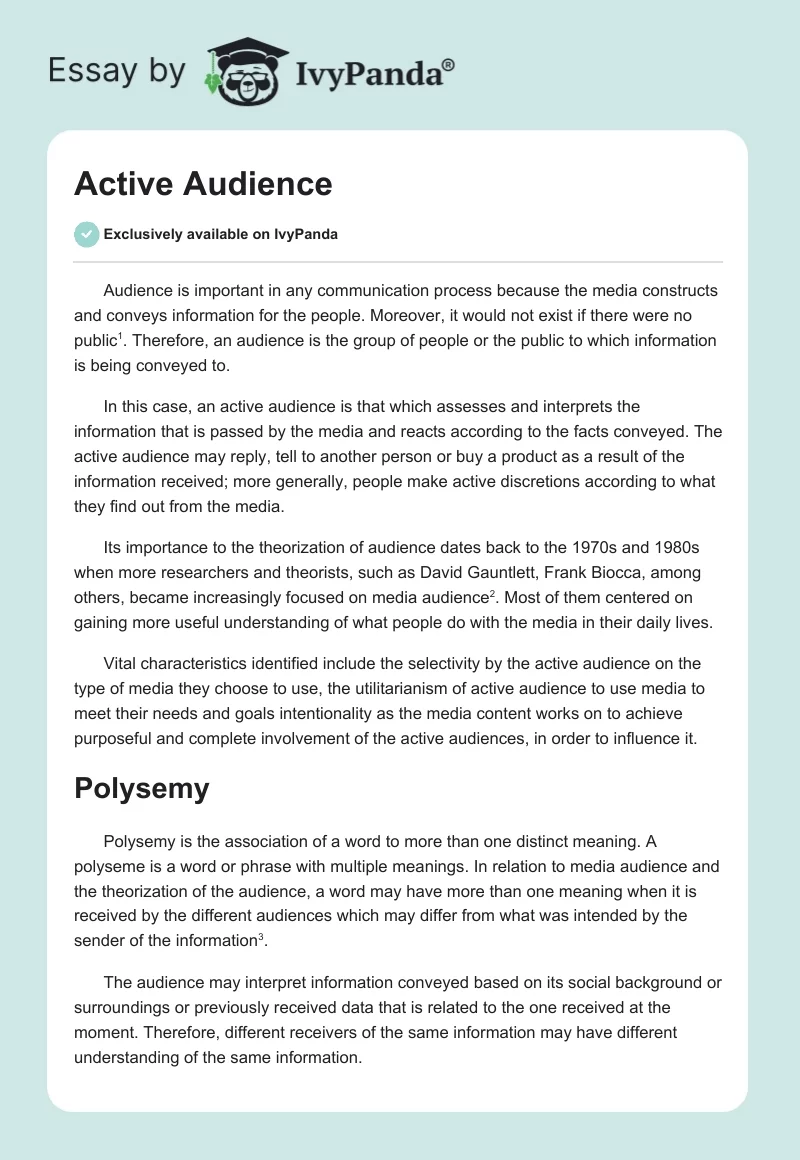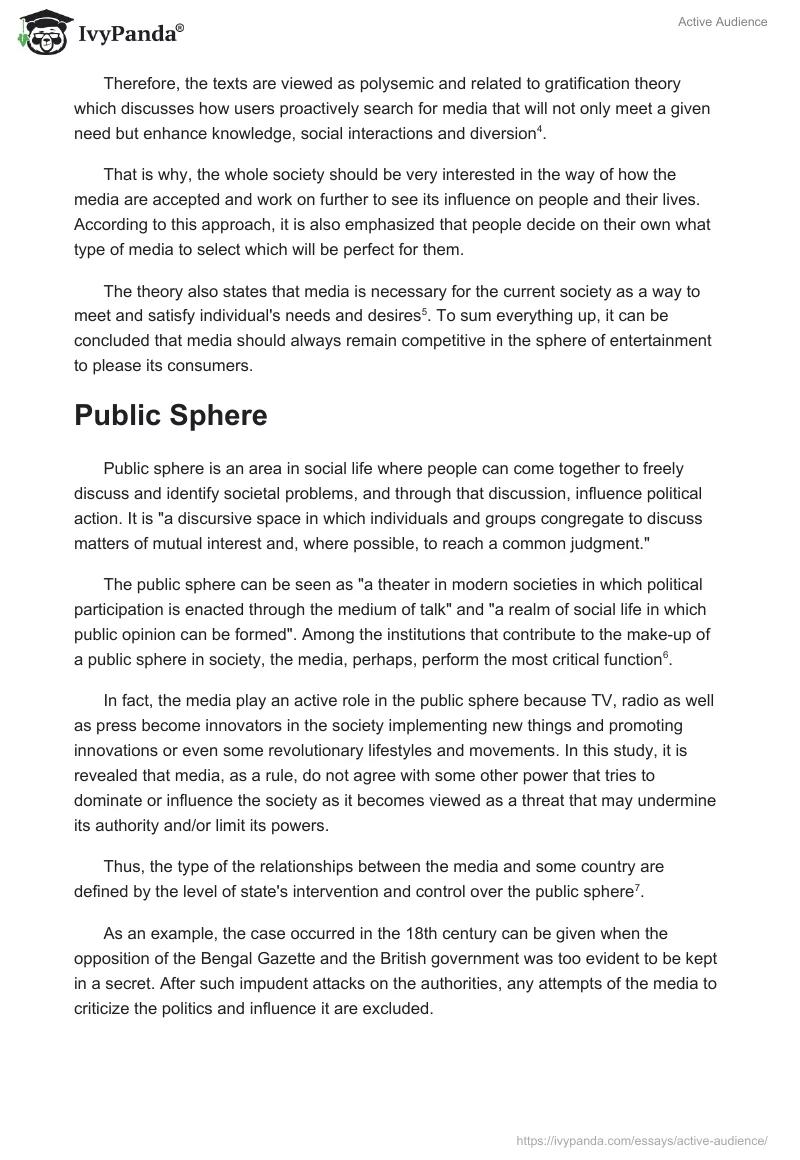Audience is important in any communication process because the media constructs and conveys information for the people. Moreover, it would not exist if there were no public. Therefore, an audience is the group of people or the public to which information is being conveyed to.
In this case, an active audience is that which assesses and interprets the information that is passed by the media and reacts according to the facts conveyed. The active audience may reply, tell to another person or buy a product as a result of the information received; more generally, people make active discretions according to what they find out from the media.
Its importance to the theorization of audience dates back to the 1970s and 1980s when more researchers and theorists, such as David Gauntlett, Frank Biocca, among others, became increasingly focused on media audience. Most of them centered on gaining more useful understanding of what people do with the media in their daily lives.
Vital characteristics identified include the selectivity by the active audience on the type of media they choose to use, the utilitarianism of active audience to use media to meet their needs and goals intentionality as the media content works on to achieve purposeful and complete involvement of the active audiences, in order to influence it.
Polysemy
Polysemy is the association of a word to more than one distinct meaning. A polyseme is a word or phrase with multiple meanings. In relation to media audience and the theorization of the audience, a word may have more than one meaning when it is received by the different audiences which may differ from what was intended by the sender of the information.
The audience may interpret information conveyed based on its social background or surroundings or previously received data that is related to the one received at the moment. Therefore, different receivers of the same information may have different understanding of the same information.
Therefore, the texts are viewed as polysemic and related to gratification theory which discusses how users proactively search for media that will not only meet a given need but enhance knowledge, social interactions and diversion.
That is why, the whole society should be very interested in the way of how the media are accepted and work on further to see its influence on people and their lives. According to this approach, it is also emphasized that people decide on their own what type of media to select which will be perfect for them.
The theory also states that media is necessary for the current society as a way to meet and satisfy individual’s needs and desires. To sum everything up, it can be concluded that media should always remain competitive in the sphere of entertainment to please its consumers.
Public Sphere
Public sphere is an area in social life where people can come together to freely discuss and identify societal problems, and through that discussion, influence political action. It is “a discursive space in which individuals and groups congregate to discuss matters of mutual interest and, where possible, to reach a common judgment.”
The public sphere can be seen as “a theater in modern societies in which political participation is enacted through the medium of talk” and “a realm of social life in which public opinion can be formed”. Among the institutions that contribute to the make-up of a public sphere in society, the media, perhaps, perform the most critical function.
In fact, the media play an active role in the public sphere because TV, radio as well as press become innovators in the society implementing new things and promoting innovations or even some revolutionary lifestyles and movements.
In this study, it is revealed that media, as a rule, do not agree with some other power that tries to dominate or influence the society as it becomes viewed as a threat that may undermine its authority and/or limit its powers. Thus, the type of the relationships between the media and some country are defined by the level of state’s intervention and control over the public sphere.
As an example, the case occurred in the 18th century can be given when the opposition of the Bengal Gazette and the British government was too evident to be kept in a secret. After such impudent attacks on the authorities, any attempts of the media to criticize the politics and influence it are excluded.
Reception Analysis
Based on polysemic understanding of texts or information by different audiences, reception analysis goes beyond the different perception and takes a close look at what is actually going on. Reception analysis concentrates more on the audience and how the people come to a particular understanding view of a text or information.
To some extent, it is obvious that each of us will decode or translate texts in ways that reflect our personal experience. So, gender, class, occupation and personal circumstances are all important in determining how we decode a text. Once it is accepted that audiences are active, it begins to construct meanings; there are obvious implications for research methodology.
Quantitative research is not suited to investigate the construction of meaning. To understand the meanings that people take from a text, it is necessary to get closer to individual audience members and engage them at a personal level-qualitative research. Once this research technique is employed, simple answers become impossible as complexity takes over.
Media Ethnography
“The term ethnography has come to be equated with virtually any qualitative research where the intent is to provide a detailed, in-depth description of everyday life and practice.”
Another term, which describes this issue, is called “thick description”; it was suggested and developed by the anthropologist Clifford Geertz who worked on an interpretive theory of culture in the 1970s. In this case, media ethnography will refer to the means in which mass media interprets using its own tools, and the use of qualitative methods, particularly ethnography, which distinguishes media anthropology from other disciplinary approaches.
The interest in and importance of the media increased with the development of studies examining this issue. However, these do not always use the anthropological methods to study ethnography. Media Ethnography is important to the theorization of audience as it establishes the cause effects through its research processes and hence eliminates room for doubts in the assessment of the audience as it relates to the process of communication with the same.
Bibliography
Abercrombie, N, Television and Society, Polity Press, Cambridge, 1996.
Bauer, RA, ‘The obstinate audience’, American Psychologist, vol. 19, no. 7, 1964, pp. 319-328.
Amacher, R & Lange, V, New Perspectives in German Literary Criticism, Princeton University Press, Princeton, 1979.
Bauer, RA & Bauer, A, ‘America, ‘Mass society,’ and mass media’, Journal of Social Issues, vol. 16 no. 4, 1960a pp.3-66.
Barwise, TP, Ehrenberg, AS & Goodhardt, GJ, ‘Glued to the box: Patterns of TV repetitive-viewing’, Journal of Communication, vol. 32, no. 5, 1982, pp. 22-29.
Berelson, B, ‘The state of communication research’ Public Opinion Quarterly, vol. 23, no. 3, 1959, pp. 1-6.
Christian, SK, ‘Making sense of audience discourses: Towards a multidimensional model of mass media reception’, European Journal of Cultural Studies vol. 67, No. 3, 2000, pp. 3; 233.
Iser, W, The Act of Reading: A Theory of Aesthetic Response, Johns Hopkins University Press, Baltimore, 1978.
Jauss, RH, Toward an Aesthetic of Reception, University of Minnesota Press, Minneapolis, 1982.
Hoey, BA, What is Ethnography?, Brianhoey.com, 2011. Web.
Holub, RC, Crossing Borders: Reception Theory, Poststructuralism, Deconstruction. University of Wisconsin, Madison, 1992.
Wood, H, ‘The mediated conversational floor: an interactive approach to audience reception analysis’, Media Culture Society, vol. 29, no. 1, 2007, p. 75-103.


